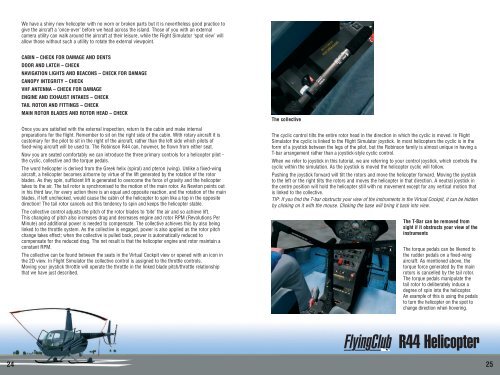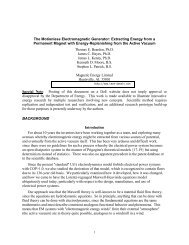flying club: r44
flying club: r44
flying club: r44
You also want an ePaper? Increase the reach of your titles
YUMPU automatically turns print PDFs into web optimized ePapers that Google loves.
We have a shiny new helicopter with no worn or broken parts but it is nevertheless good practice togive the aircraft a ‘once-over’ before we head across the island. Those of you with an externalcamera utility can walk around the aircraft at their leisure, while the Flight Simulator ‘spot view’ willallow those without such a utility to rotate the external viewpoint.CABIN – CHECK FOR DAMAGE AND DENTSDOOR AND LATCH – CHECKNAVIGATION LIGHTS AND BEACONS – CHECK FOR DAMAGECANOPY INTEGRITY – CHECKVHF ANTENNA – CHECK FOR DAMAGEENGINE AND EXHAUST INTAKES – CHECKTAIL ROTOR AND FITTINGS – CHECKMAIN ROTOR BLADES AND ROTOR HEAD – CHECKOnce you are satisfied with the external inspection, return to the cabin and make internalpreparations for the flight. Remember to sit on the right side of the cabin. With rotary aircraft it iscustomary for the pilot to sit in the right of the aircraft, rather than the left side which pilots offixed-wing aircraft will be used to. The Robinson R44 can, however, be flown from either seat.Now you are seated comfortably we can introduce the three primary controls for a helicopter pilot -the cyclic, collective and the torque pedals.The word helicopter is derived from the Greek helix (spiral) and pteron (wing). Unlike a fixed-wingaircraft, a helicopter becomes airborne by virtue of the lift generated by the rotation of the rotorblades. As they spin, sufficient lift is generated to overcome the force of gravity and the helicoptertakes to the air. The tail rotor is synchronised to the motion of the main rotor. As Newton points outin his third law, for every action there is an equal and opposite reaction, and the rotation of the mainblades, if left unchecked, would cause the cabin of the helicopter to spin like a top in the oppositedirection! The tail rotor cancels out this tendency to spin and keeps the helicopter stable.The collective control adjusts the pitch of the rotor blades to ‘bite’ the air and so achieve lift.This changing of pitch also increases drag and decreases engine and rotor RPM (Revolutions PerMinute) and additional power is needed to compensate. The collective achieves this by also beinglinked to the throttle system. As the collective is engaged, power is also applied as the rotor pitchchange takes effect; when the collective is pulled back, power is automatically reduced tocompensate for the reduced drag. The net result is that the helicopter engine and rotor maintain aconstant RPM.The collective can be found between the seats in the Virtual Cockpit view or opened with an icon inthe 2D view. In Flight Simulator the collective control is assigned to the throttle controls.Moving your joystick throttle will operate the throttle in the linked blade pitch/throttle relationshipthat we have just described.The collectiveThe cyclic control tilts the entire rotor head in the direction in which the cyclic is moved. In FlightSimulator the cyclic is linked to the Flight Simulator joystick. In most helicopters the cyclic is in theform of a joystick between the legs of the pilot, but the Robinson family is almost unique in having aT-bar arrangement rather than a joystick-style cyclic control.When we refer to joystick in this tutorial, we are referring to your control joystick, which controls thecyclic within the simulation. As the joystick is moved the helicopter cyclic will follow.Pushing the joystick forward will tilt the rotors and move the helicopter forward. Moving the joystickto the left or the right tilts the rotors and moves the helicopter in that direction. A neutral joystick inthe centre position will hold the helicopter still with no movement except for any vertical motion thatis linked to the collective.TIP: If you find the T-bar obstructs your view of the instruments in the Virtual Cockpit, it can be hiddenby clicking on it with the mouse. Clicking the base will bring it back into view.The T-Bar can be removed fromsight if it obstructs your view of theinstrumentsThe torque pedals can be likened tothe rudder pedals on a fixed-wingaircraft. As mentioned above, thetorque force generated by the mainrotors is cancelled by the tail rotor.The torque pedals manipulate thetail rotor to deliberately induce adegree of spin into the helicopter.An example of this is using the pedalsto turn the helicopter on the spot tochange direction when hovering.R44 Helicopter2425



